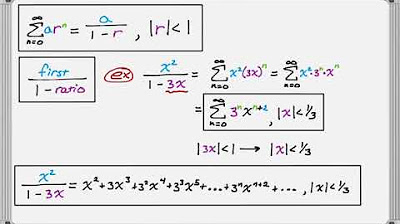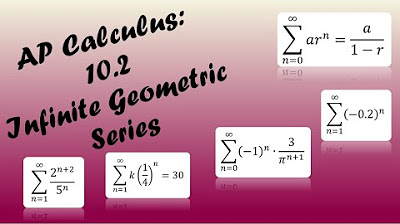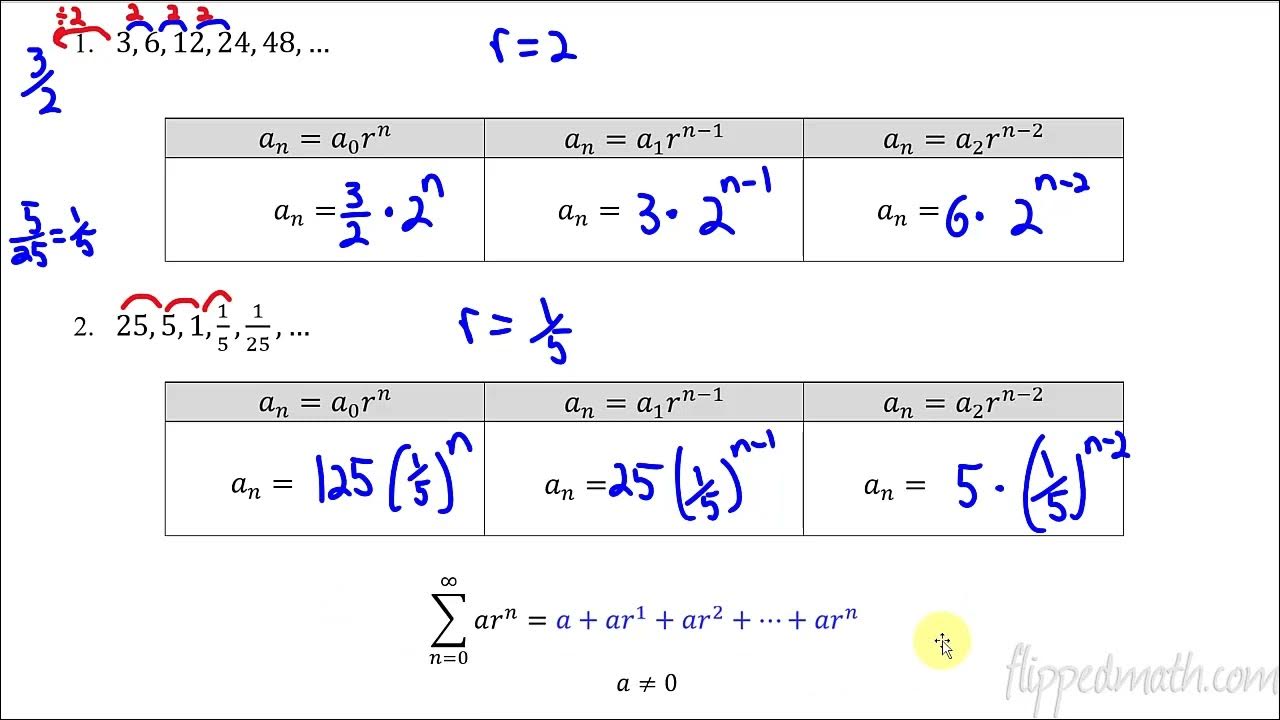Sequences and series (part 2)
TLDRIn this video, the presenter delves into the concept of geometric series, explaining the formula for their sum and demonstrating its application with examples. The video also explores the intriguing idea of infinite geometric series and their convergence, particularly highlighting the surprising result of the sum of an infinite series with a base of 1/2, which equals 2.
Takeaways
- 📚 The concept of a geometric series was introduced, where a base 'a' is raised to increasing exponents and summed up.
- 🧠 A mistake was acknowledged in a previous video regarding the exponent notation, which should be 'a to the N' instead of 'a to the n minus 2'.
- 🔄 A new sum, defined as 'a times s', involves distributing 'a' across the entire geometric series.
- 🌟 The formula for the sum of a finite geometric series was derived as 'a to the n plus 1 minus 1 over a minus 1'.
- 📝 An example was provided to calculate the sum of the powers of 3 up to 3 to the 10th power using the derived formula.
- 🤔 The usefulness of the formula was highlighted, especially for cases where the base is a power of ten, simplifying the calculations.
- 🌌 The concept of infinite series was explored, with a focus on series that converge to a finite sum, requiring the terms to decrease towards infinity.
- 🏞️ A specific case was discussed where the base 'a' is a fraction, such as 1/2, and how the series approaches a finite value as 'n' approaches infinity.
- 📈 The limit concept was applied to find the sum of an infinite geometric series with a base of 1/2, resulting in the finite value of 2.
- 💡 The amazement was expressed at how an infinite sum of terms could result in a finite, neat number, specifically highlighting the sum of powers of 1/2.
Q & A
What is a geometric series?
-A geometric series is a sequence of numbers where each term is found by multiplying the previous term by a constant, known as the base.
How is the sum of a geometric series calculated?
-The sum of a geometric series, denoted as 's', can be calculated using the formula s = a^(n+1) - 1 / (a - 1), where 'a' is the base and 'n' is the number of terms.
What is the significance of the base 'a' in a geometric series?
-The base 'a' determines the common ratio between consecutive terms in the geometric series. It can be any number except 1, as a series with a base of 1 would not be geometric.
What happens when you multiply the sum 's' by the base 'a'?
-Multiplying the sum 's' by the base 'a' results in a new series where each term is 'a' times the corresponding term in the original series. This new sum can be calculated as a*s.
How does subtracting the original sum 's' from the new sum a*s result in a formula for 's'?
-Subtracting the original sum 's' from a*s results in a series where all terms cancel out except the first and the last, leading to the formula s = a^(n+1) - 1 / (a - 1).
What is an infinite geometric series and how does it converge?
-An infinite geometric series is a series that extends to infinity. It converges if the absolute value of the base 'a' is less than 1, meaning each term gets smaller as you go to more terms.
What is the sum of an infinite geometric series with a base of 1/2?
-The sum of an infinite geometric series with a base of 1/2 is 2, as calculated by the formula s = 1/(1 - 1/2).
How does the concept of limits play a role in the sum of an infinite geometric series?
-Limits are used to find the sum of an infinite geometric series. It involves taking the limit as the number of terms 'n' approaches infinity, which gives the value the sum approaches.
What happens to the term 1/2^n as 'n' approaches infinity?
-As 'n' approaches infinity, the term 1/2^n approaches zero, because raising a fraction to an infinitely large exponent makes it approach zero.
What is the practical application of understanding geometric series?
-Understanding geometric series is useful in various fields such as finance, physics, and engineering, where phenomena may involve exponential growth or decay, or when calculating the total of a sequence of payments or returns over time.
How does the formula for the sum of a finite geometric series relate to the formula for an infinite geometric series?
-The formula for the sum of a finite geometric series is a direct application of the formula for an infinite geometric series, with the difference being that 'n' is finite and thus the series has an end term.
Outlines
📚 Understanding the Geometric Series
This paragraph introduces the concept of the geometric series, a sequence where each term is found by multiplying the previous term by a fixed, non-zero number called the common ratio. The speaker discusses the series' formula, which involves summing up the terms up to a certain exponent n, and corrects a mistake from a previous video regarding the exponent notation. The speaker then explores the concept of another sum, defined as 'a times s', where 'a' is the common ratio and 's' is the sum of the geometric series. Through algebraic manipulation, the speaker derives a formula for this new sum and sets the stage for further exploration in the subsequent paragraphs.
🔢 Applying the Geometric Series Formula
In this paragraph, the speaker applies the geometric series formula to a practical example, calculating the sum of the powers of 3 up to the 10th power. The speaker emphasizes the usefulness of the formula, especially when dealing with bases that are powers of ten. The discussion then transitions to the concept of infinite series and convergence, using the example of a geometric series with a fractional base (1/2) to demonstrate how an infinite number of terms can sum up to a finite number. The speaker concludes by marveling at the result of the sum of an infinite geometric series with a base of 1/2, which equals 2, and suggests a related project for the audience to visualize the convergence of the series.
Mindmap
Keywords
💡Geometric Series
💡Exponential Functions
💡Summation
💡Distributed
💡Convergence
💡Limit
💡Infinite Series
💡Formula
💡Negative Terms
💡Powers
💡Fraction
Highlights
Introduction to geometric series with base 'a'.
Discussion on the sum of a geometric series up to a number a to the power of n.
Correcting a mistake from the previous video regarding the exponent notation.
Definition of a new sum, 'as', which is 'a' times the sum 's' of the geometric series.
Explanation of the distribution of 'a' across the sum, leading to a new series.
Derivation of the result 'as - s' and its simplification.
Introduction to the formula for the sum of a geometric series: S = a^(n+1) - 1 / (a - 1).
Illustration of the formula's application with an example involving the base 3 raised to various powers.
Explanation of the difference between finite and infinite series and the concept of convergence.
Discussion on the sum of an infinite geometric series with a base of 1/2.
Application of the derived formula to the case of 1/2 raised to the power of k from k=0 to infinity.
Exploration of the limit as n approaches infinity in the context of the geometric series.
Revealing the surprising result that the sum of an infinite geometric series with a base of 1/2 converges to 2.
Amazement at the fact that an infinite sum can result in a finite number.
Suggestion for a project to visualize the convergence of the infinite geometric series with a base of 1/2.
Conclusion of the video with a teaser for the next session.
Transcripts
Browse More Related Video

Sum of an infinite geometric series | Sequences, series and induction | Precalculus | Khan Academy

Geometric Series Summing to Functions

AP Calculus BC Lesson 10.2

Geometric Series (Precalculus - College Algebra 72)

Calculus BC – 10.2 Working with Geometric Series

Power series of ln(1+x_) | Series | AP Calculus BC | Khan Academy
5.0 / 5 (0 votes)
Thanks for rating: